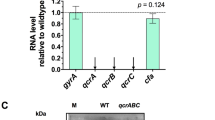Abstract
Tetrachloroethene (PCE) respiration was studied in the tetrachloroethene-utilizing anaerobe,Dehalospirillum multivorans, with respect to localization of the catabolic enzymes, the electron carriers potentially involved in electron transport, and the response to ionophores and specific inhibitors. Hydrogenase and formate dehydrogenase were recovered in the periplasmic cell fraction and were membrane-associated. Electron-accepting tetrachloroethene dehalogenase was found in the cytoplasmic fraction. In the PCE dehalogenase assay, only artificial electron donors with a standard redox potential of <-360 mV were effective electron donors for PCE reduction. Besides these artificial reductants, ferredoxin isolated fromD. multivorans (E′o=-445 mV) could serve as electron donor for PCE reduction. However, the reaction rate with ferredoxin was only 1% of that with methyl viologen, whereas the pyruvate-ferredoxin oxidoreductase exhibited almost the same reaction rates with methyl viologen and ferredoxin as electron acceptors for pyruvate oxidation. Reduced menadione (2-methyl-1,4-naphthoquinone) did not serve as electron donor in the PCE dehalogenase reaction. 2-Heptyl-4-hydroxyquinoline-N-oxide (HOQNO) had no significant effect on PCE dechlorination in cell suspensions and in crude extracts. Whole cells catalyzed the reductive dechlorination of PCE with H2 or formate as electron donors. The dechlorination in cell suspensions rather than in cell extracts was inhibited by the ionophores carbonylcyanide-p-(trifluoromethoxy)-phenylhydrazone (FCCP) and tetrachlorosalicylanilide (TCS), indicating that a membrane potential and/or a pH gradient may be required for the reaction in vivo.
Similar content being viewed by others
Abbreviations
- CTAB :
-
N-cetyl-trimethylammonium bromide
- DCE :
-
cis-1,2-Dichloroethene
- FCCP :
-
Carbonyl cyanide-p-(trifluoromethoxy)phenylhydrazone
- Fd :
-
Ferredoxin
- HOQNO :
-
2-Heptyl-4-hydroxyquinoline-N-oxide
- MV :
-
Methyl viologen
- PCE :
-
Tetrachloroethene or perchloroethylene
- Pyr :
-
Pyruvate
- TCE :
-
Trichloroethene
- TCS :
-
Tetrachlorosalicylanilide
References
Bradford MM (1976) A rapid and sensitive method for the quantitation of microgram quantities of protein utilizing the principle of protein-dye binding. Anal Biochem 72:248–254
Fewson CA, Baker DP, Chalmers RM, Keen JN, Hamilton ID, Scott AJ, Yasin M (1993) Relationships amongst some bacterial and yeast lactate and mandelate dehydrogenases. J Gen Microbiol 139:1345–1352
Fish WW (1988) Rapid colorimetric micromethod for the quantitation of complexed iron in biological samples. In: Mc Cormick DB, Wright LD (eds) Methods in enzymology, vol 158. Academic Press, New York San Francisco London, pp 357–364
Harder SR, Lu WP, Feinberg BA, Ragsdale SW (1989) Spectroelectrochemical studies of the corrinoid/iron-sulfur protein involved in acetyl coenzyme A synthesis byClostridium thermoaceticum. Biochemistry 28:9080–9087
Holliger C, Schumacher W (1994) Reductive dehalogenation as a respiratory process. Antonie Van Leeuwenhoek 66:239–246
Kröger A, Geisler V, Lemma E, Theis F, Lenger R (1992) Bacterial fumarate respiration. Arch Microbiol 158:311–314
Loubière P, Lindley ND (1991) The use of acetate as additional co-substrate improves methylotrophic growth of the acetogenic anaerobeEubacterium limosum when CO2 fixation is rate-limiting. J Gen Microbiol 137:2247–2251
Neumann A, Scholz-Muramatsu H, Diekert G (1994) Tetrachloroethene metabolism ofDehalospirillum multivorans. Arch Microbiol 162:295–301
Neumann A, Wohlfarth G, Diekert G (1995) Properties of the tetrachloroethene and trichloroethene dehalogenase ofDehalospirillum multivorans. Arch Microbiol 163:276–281
Neumann A, Wohlfarth G, Diekert G (1996) Purification and characterization of tetrachloroethene reductive dehalogenase fromDehalospirillum multivorans. J Biol Chem 271:16515–16519
Nicholls DG, Ferguson SJ (1992) Bioenergetics 2. Academic Press, San Diego
Rabinowitz JC (1978) Analysis of acid-labile sulfide and sulfhydryl groups. In: Colowick SP, Caplan NO (eds) Methods in enzymology, vol 53. Academic Press, New York San Francisco London, pp 275–277
Reubelt U, Wohlfarth G, Schmid R, Diekert G (1991) Purification and characterization of ferrdoxin fromPeptostreptococcus productus (strain Marburg). Arch Microbiol 156:422–426
Scholz-Muramatsu H, Neumann A, Meßmer M, Moore E, Diekert G (1995) Isolation and characterization ofDehalospirillum multivorans gen. nov. sp. nov., a tetrachloroethene-utilizing, strictly anaerobic bacterium. Arch Microbiol 163:48–56
Schumacher W, Holliger C (1996) The proton electron ratio of the menaquinone-dependent electron transport from dihydrogen to tetrachloroethene in “Dehalobacter restrictus” J Bacteriol 178: 2328–2333
Unden G, Hackenberg H, Kröger A (1980) Isolation and functional aspects of the fumarate reductase involved in the phosphorylative electron transport ofVibrio succinogenes. Biochim Biophys Acta 591:275–288
Wetzstein HG, Gottschalk G (1985) A sodium-stimulated membrane-bound fumarate reductase system inBacteroides amylophilus. Arch Microbiol 143:157–162
Zehnder AJB, Wuhrmann K (1976) Titanium(III) citrate as a nontoxic, oxidation-reduction buffering system for the culture of obligate anaerobes. Science 194:1165–1166
Author information
Authors and Affiliations
Corresponding author
Additional information
Dedicated to Prof. Achim Kröger on the occasion of his 60th birthday, especially in honor of his excellent contributions to the elucidation of anaerobic respiration processes
Rights and permissions
About this article
Cite this article
Miller, E., Wohlfarth, G. & Diekert, G. Studies on tetrachloroethene respiration inDehalospirillum multivorans . Arch. Microbiol. 166, 379–387 (1996). https://doi.org/10.1007/BF01682983
Received:
Accepted:
Issue Date:
DOI: https://doi.org/10.1007/BF01682983




